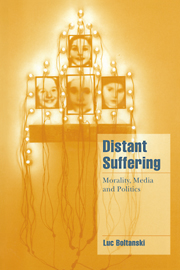7 - The aesthetic topic
Published online by Cambridge University Press: 22 September 2009
Summary
A third way
To summarise, on the one hand there is an unfortunate who suffers and on the other a spectator who views the suffering without undergoing the same fate and without being directly exposed to the same misfortune. To adopt an acceptable attitude, the spectator cannot remain indifferent nor draw a solitary enjoyment from the spectacle. However, he cannot always intervene directly; he cannot always go into action, that is to say, unify the framework within which he acts and the framework within which the unfortunate struggles in such a way as to bring together in a single situation the two originally different situations. The further the spectator is from the unfortunate the more the disjunction between their situations seems to be insurmountable and in consequence action becomes more problematic. We have seen that a politics of pity necessarily provokes this disjunction because, as a politics, it must rise above local miseries in order to form a general picture, although in order to keep the dimension of pity present it cannot be content with establishing equivalences, of an accounting kind for example, and must therefore compose this picture by assembling particular sufferings in such a way as to obtain an immense imaginary collection of all kinds of unfortunates.
Information
- Type
- Chapter
- Information
- Distant SufferingMorality, Media and Politics, pp. 114 - 130Publisher: Cambridge University PressPrint publication year: 1999
